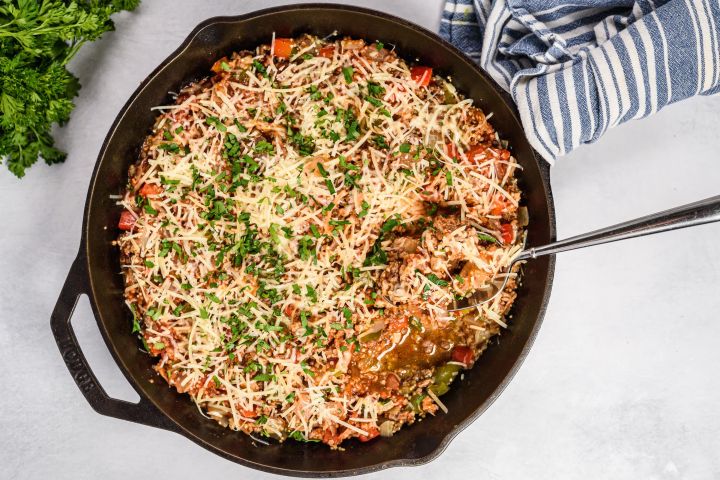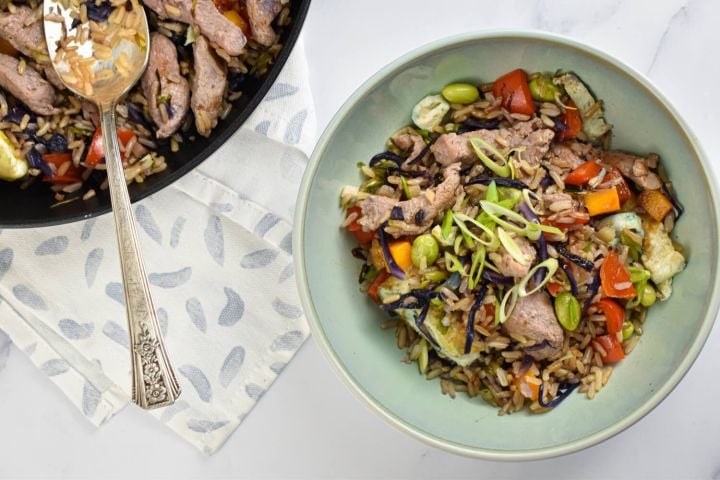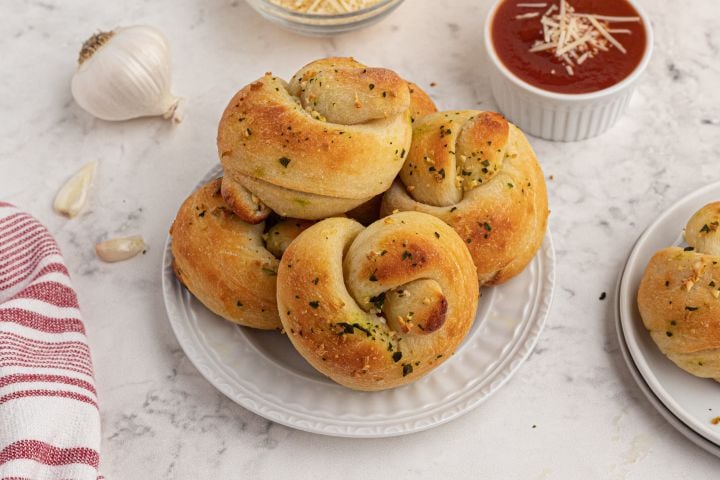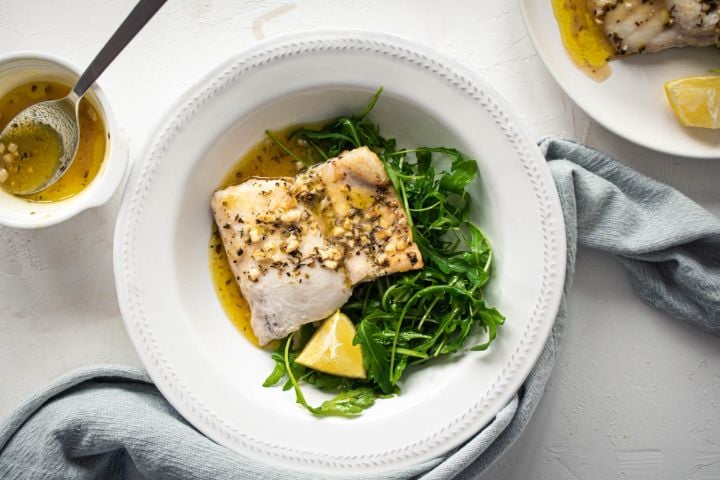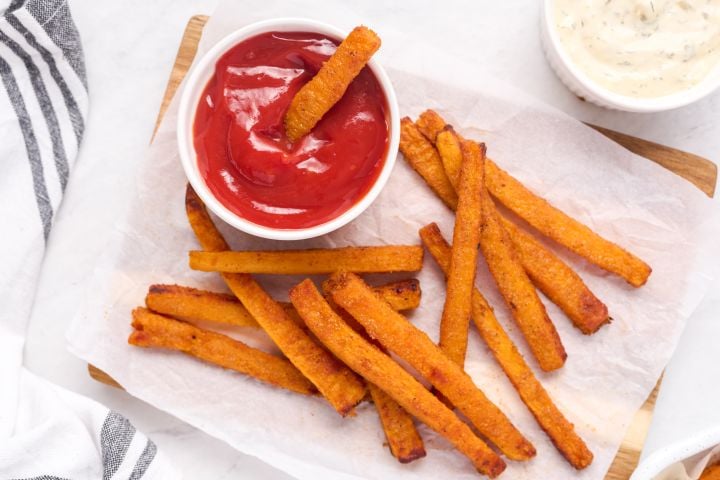Parmesan Polenta with Basil
Creamy Parmesan Polenta with fresh basil is a delicious Italian side dish that's made with yellow cornmeal, milk, and Parmesan cheese. Ready in just 30 minutes, this homemade polenta is the ultimate comfort food.
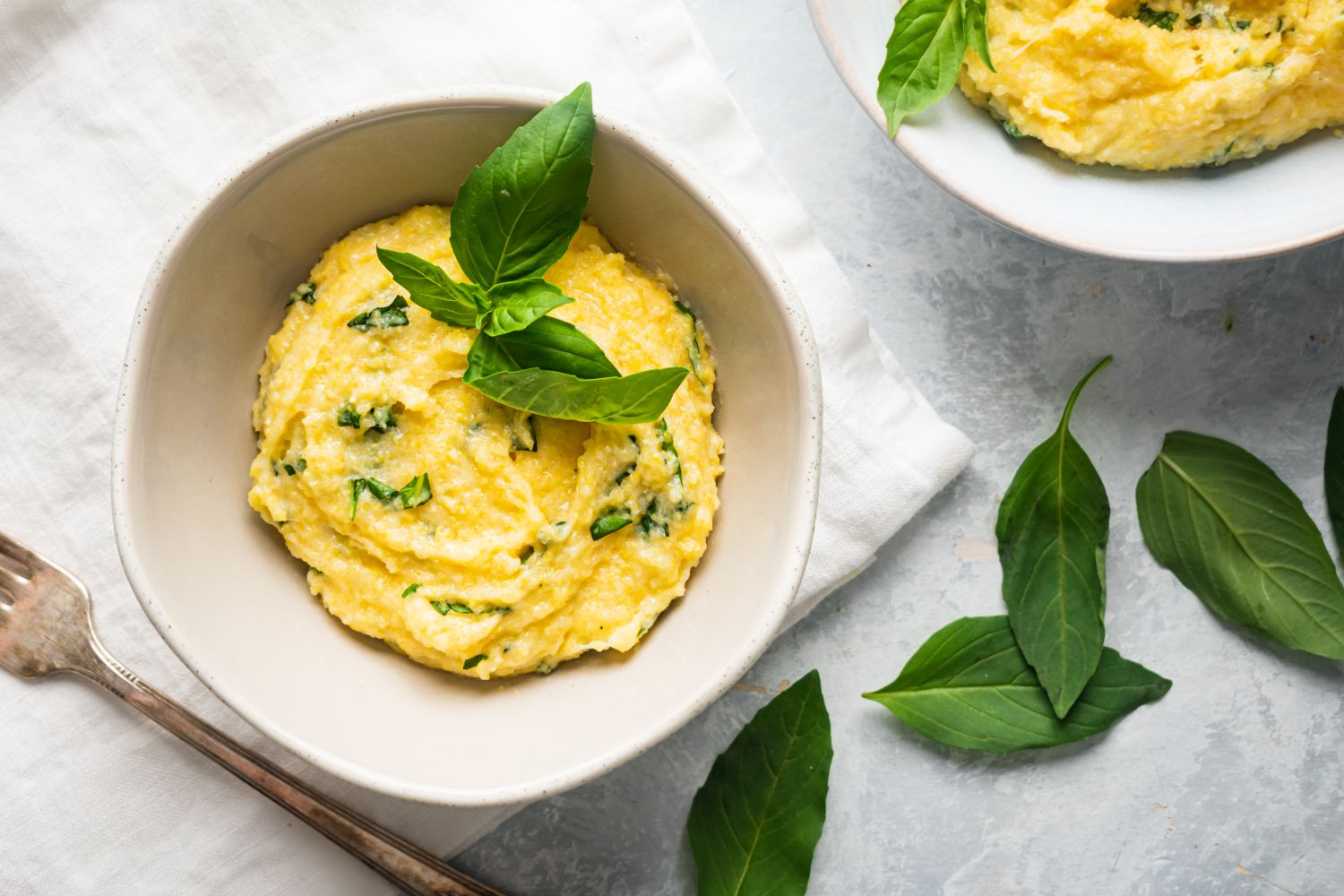
Polenta is one of my favorite side dishes especially as the weather starts to cool down. It has the magical ability to take any dish and instantly make it comfort food. Serve this creamy parmesan polenta with everything from roasted vegetables to tender beef ragu to pan roasted rosemary chicken - you name the dish, it almost always can work over a bed of warm and creamy polenta.
While there are lots of ways to prepare polenta, I almost always make it on the stovetop using a combination of vegetable or chicken broth and milk. The broth adds flavor and there is still plenty of creaminess from the milk. It's the perfect combination in my opinion.
If you haven't cooked polenta before, the first ten minutes of cooking polenta are the most important as you whisk, and whisk, and whisk some more to make sure the polenta is smooth. After that, it just needs to be occasionally stirred as it continues to cook. The longer polenta is cooked, the more voluminous it will become. I find around 30 minutes is the sweet spot for creamy and soft polenta.
To finish up the dish, just stir in the fresh basil, plenty of Parmesan cheese, salt, and black pepper. Delicious.
Polenta can also be cooked in the oven like this Baked Polenta with Vegetables, cooked into tasty Polenta Fries, or make it a meal of it like these polenta bowls.

What is polenta?
Polenta is a popular Italian porridge made with yellow cornmeal. It is used as a side dish or base for many meals and is often served with braised meats, vegetables, and stews.
Polenta is usually made with coarsely ground yellow cornmeal combined with water or broth, butter, milk or cream, cheese, salt, and pepper. It's creamy almost like a porridge or grits. Quicker cooking polenta is made with fine-grain cornmeal. You can also find packaged cornmeal that has already been cooked.
In terms of taste, since polenta is made from corn, it has a mild corn flavor. It is slightly sweet and has a similar flavor to cornbread or grits.
What you'll need for Parmesan Polenta
- Polenta: Choose stone-ground, coarse, or medium-ground polenta for the best results with this recipe. Make sure not to choose fine-ground or instant polenta. Also, the polenta that comes precooked in a tube will not work for making creamy polenta. That polenta is best for baking or fries.
- Broth: Choose a flavorful chicken or vegetable broth since it will add a lot of flavor to the polenta. If you decide to use water, plan on adding some extra seasoning. Bullion can also be used.
- Milk: Any milk will work in this recipe but the higher the fat content of the milk, the creamier the polenta will turn out.
- Parmesan cheese: Freshly grated Parmesan cheese will always have the best flavor. Pre-shredded or grated Parmesan cheese will work but you may need to add extra to achieve the same flavor.
- Basil: For this recipe, fresh basil is best. Dried will work but the flavor will be slightly different. Other herbs could also be added including rosemary, oregano, parsley, thyme, or chives.
What is the best way to cook creamy polenta?
Polenta has a bit of a reputation for being difficult to cook and turning out gritty or flavorless. With the right technique, polenta is easy to make. Here's what you need to do to make creamy and flavorful polenta every time.
- To ensure creamy polenta, it is extremely important to slowly whisk the polenta into the boiling water. Add the polenta slowly, whisking well as you add it. This prevents lumping and ensures a smooth polenta. Then during the first ten minutes, keep whisking the polenta. The whisking is what makes the polenta soft, fluffy, and creamy.
- Use vegetable or chicken stock to ensure the polenta is flavorful. Make sure to add enough salt. Many times if your polenta is bland, it simply lacks salt. Salting the water is very important if you aren't using stock or broth.
- Milk, cream, butter, cream cheese, and Parmesan cheese are all great ways to add flavor to polenta.
- If the polenta becomes too thick before it is finished cooking, add more liquid to the mixture. The polenta will need about 30 minutes to soften, so if the polenta becomes hard to stir or overly thick before it is soft, it needs more liquid.
- The polenta will thicken as it sits. If you aren't serving it right away, be prepared to add some more liquid and slowly warm over low heat until it thins out to your desired texture.
- Any time you add extra liquid to polenta, know that you may need to also add some extra seasoning.

What to serve with cheesy Parmesan polenta?
Polenta pairs well with many dishes and can be used as a substitute for mashed potatoes, pasta, rice, or grains. Here are some of our favorite ways to serve polenta.
- Turkey Meatballs
- Hearty Beef Stew
- Roasted Balsamic Chicken
- Garlic Parmesan Shrimp and Broccoli
- Balsamic Grilled Vegetables
Recipe Ideas and Tips
- For a super creamy and cheesy polenta, add some cream cheese right before serving.
- Try this dish with different herbs like thyme, rosemary, parsley, or chives.
- Add more nutrients by adding some fresh spinach to the polenta, like this Creamy Spinach Polenta.
- For an extra hint of nutty flavor, add a touch of nutmeg to the cooked polenta.
- To make really rich polenta, swap in heavy cream for the milk.
Storing and Reheating Polenta
The polenta will thicken and harden as it cools and sits. That can make storing and reheating polenta a little tricky.
Always let the polenta cool completely before storing it. Then when you want to reheat, heat it over low heat and add extra liquid to thin it out. Whisk and stir until it is heated through and reached your desired texture.
Once the polenta has cooled, you can also cut it into squares. Bake, fry, or toast the leftover polenta squares. The texture will be thicker and similar to the packaged polenta tubes sold in stores.
Frequently Asked Questions
Here are some of the most common questions about cooking polenta.
Why is my polenta gritty?
Gritty polenta happens when the polenta isn't cooked long enough, is added to the liquid too quickly, or isn't cooked with enough liquid. Always make sure to slowly add the polenta to the boiling water and whisk constantly. This breaks up clumps and ensures the polenta doesn't stick together, causing a thicker, grittier texture.
Also, make sure the polenta is fully cooked through and add liquid if it becomes too thick. Just make sure to whisk the liquid into the polenta well.
Is cornmeal the same as polenta?
Polenta is made from cornmeal but it is a thicker, more coarse grain. If you swap in normal cornmeal, which is usually fine grain, the polenta will be mushy. Make sure to look for coarse cornmeal or a package labeled polenta.
Can this be made without cheese?
This polenta recipe works great without the Parmesan cheese, just make sure to add extra salt to ensure the polenta is well seasoned.
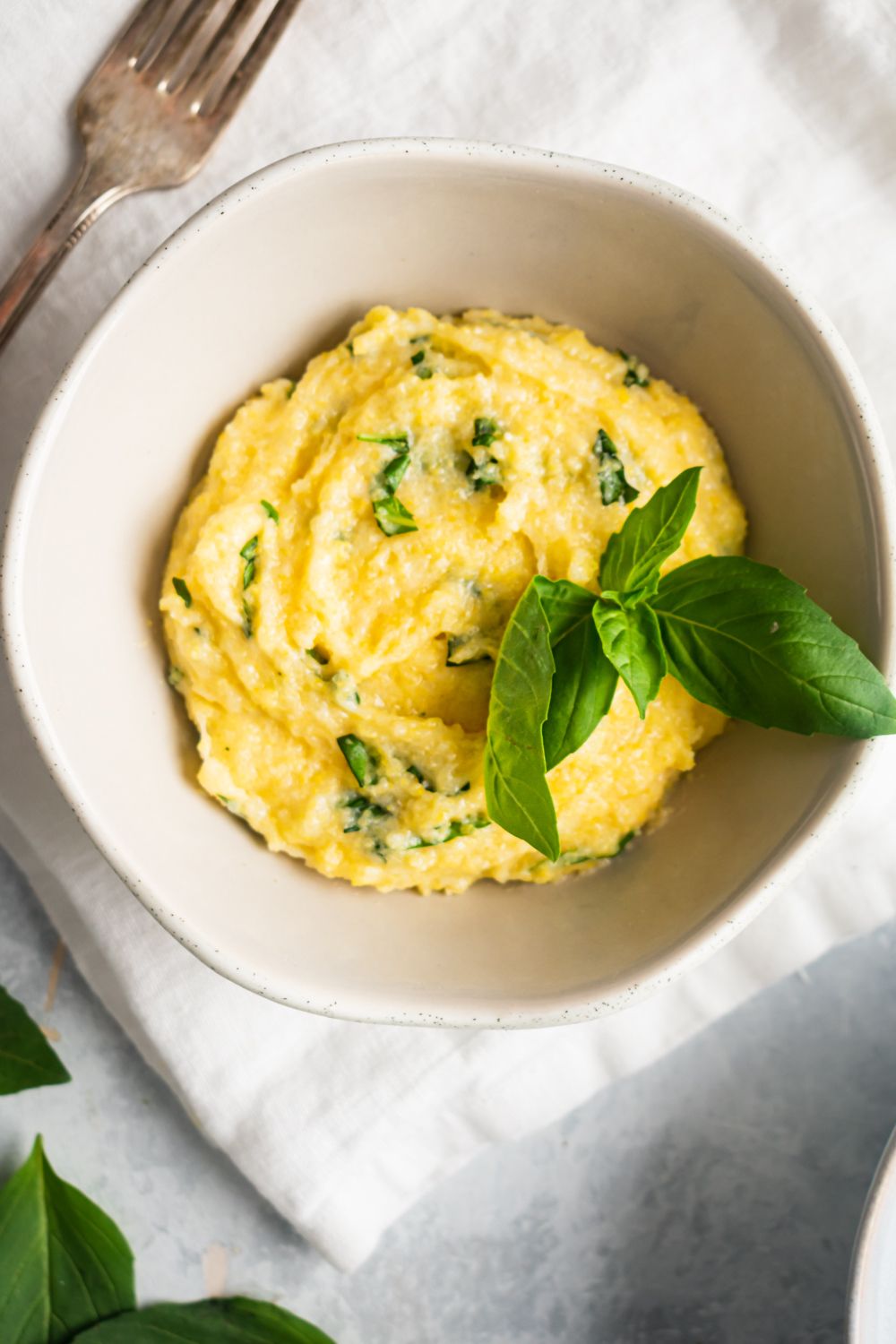
Parmesan Polenta with Basil
- Download
- Send to your inbox
Ingredients
-
2 cups vegetable broth (or chicken broth)
-
1 cup nonfat milk
-
1/2 tsp. salt
-
3/4 cup polenta, dry
-
1/4 cup fresh basil
-
1/4 cup Parmesan cheese
-
Salt and pepper
Instructions
(Hide Media)Switch to prevent your screen from going dark.
* Percent Daily Values are based on a 2,000 calorie diet. Your daily values may be higher or lower depending on your calorie needs.
The Nutritional Values provided are estimates only and may vary based on the preparation method.

Get delicious, healthy recipes delivered each week right to your inbox.

Snap a picture and show us what you made on Instagram or Facebook.
Tag us using @SlenderKitchen or #slenderkitchen.








